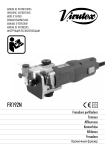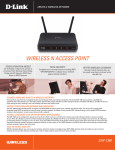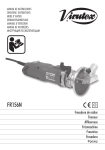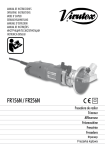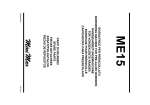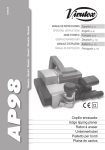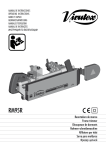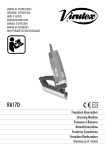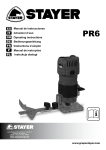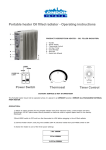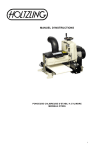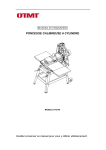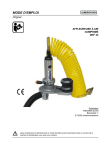Download ESPAÑOL Fresadora de cantos inclinable FR292R 6
Transcript
MANUAL DE INSTRUCCIONES OPERATING INSTRUCTIONS MODE D'EMPLOI GEBRAUCHSANWEISUNG MANUALE D'ISTRUZIONI MANUAL DE INSTRUÇÕES ИНСТРУКЦИЯ ПО ЭКСПЛУАТАЦИИ página/page seite/pagina страница ESPAÑOL Fresadora de cantos inclinable FR292R 6 ENGLISH FR292R Tiltable trimmer FRANÇAIS Affleureuse inclinable FR292R 12 DEUTSCH Schwenkbare Kantenfräse FR292R 15 ITALIANO Fresatrice inclinabile FR292R 18 PORTUGUÉS Fresadora inclinável FR292R 22 РУССКИЙ FR292R Фрезер кромочный 25 9 A1 A D Fig. 1 H B O H Fig. 3 2 X M M1 H Fig. 2 Fig. 4 H Fig. 5 C E A D Y E B L H K W A Y G1 D B H E M N F Fig. 6 Fig. 7 M1 Fig. 8 B D Y N A M H F M1 Fig. 9 3 N Fig. 10 R Fig. 11 a1 b1 a2 b2 c d e f f1 g1 g2 h i j Fig. 13 Fig. 12 4 k Fig. 15 Fig. 14 H B3 Fig. 16 T V R S Fig. 17 Q Fig. 18 5 incluida de origen. Fresas par aplicaciones varias: Ver página 29 6446073 Acoplamiento de aspiración ¡ATENCIÓN! Utilizar siempre fresas con el diámetro de la caña adecuado a la pinza que va a utilizar y adaptadas a la velocidad de la màquina. 12. NIVEL DE RUIDO Y VIBRACIONES Las mediciones de esta herramienta eléctrica han sido efectuadas según Norma Europea EN50144. El nivel de ruidos en el puesto de trabajo puede sobrepasar 85 dB(A). En este caso es necesario tomar medidas de protección contra el ruido para el usuario de la herramienta. 13. GARANTÍA Todas las máquinas electroportátiles VIRUTEX tienen una garantía válida de 12 meses a partir del día de su suministro, quedando excluidas todas las manipulaciones o daños ocasionados por manejos inadecuados o por desgaste natural de la máquina. Para cualquier reparación dirigirse al servicio oficial de asistencia técnica VIRUTEX. VIRUTEX se reserva el derecho de modificar sus productos sin previo aviso. English FR292R TILTABLE TRIMMER IMPORTANT CAUTION. Read these OPERATING INSTRUCTIONS and the attached GENERAL SAFETY INSTRUCTIONS LEAFLET carefully before using the machine. Make sure you have understood them before operating the machine for the first time. Keep both sets of instructions for any future queries. 1. SAFETY INSTRUCTIONS FOR USING THE ROUTER 1.WARNING! Carefully read the GENERAL SAFETY INSTRUCTION LEAFLET enclosed with the machine documents. 2. Before plugging in the machine, make sure that the power supply voltage is the same as that shown on the specifications plate. 3. Always keep your hands away from the cutting area. Always grip the machine safely. 4. Use protective goggles. 5. Always use original VIRUTEX tools. Never use defective or damaged tools. 6. Always use cutter bits with the appropriate stem diameter for the chuck collet and tool speed to be used. 7. WARNING! Unplug the machine from the power supply before performing any maintenance opera- tions. 2. SPECIFICATIONS Power..............................................................750 W Universal motor..............................………..50/60 Hz Revolutions..............................14,000 – 30,000/min Ø max bit...........................................………..25 mm Ø standard chuck collet........................…….6 and 8 mm Weighted equivalent acoustic, continuous pressure level...............................83 dB(A) Acoustic pressure level..............................98 dB(A) Usual vibration level (hand-arm)....................<2.5 m/s2 Weight..................................................……...2.2 Kg 3. STANDARD EQUIPMENT Inside the carrying case the following items will be found: • FR292R Router with 8- and 6-mm chucks. • Straight cutter for trimming and slotting D.18 LC. 20 • Key: 11 mm for motor shaft. • Key: 19 mm for chuck collet attachment. • Copying device • Lateral square with centring shaft • 3-mm Allen wrench • Operating instructions and other documents 4. GENERAL DESCRIPTION OF THE ROUTER The FR292R router can be used for trimming laminates, shaping small mouldings, rabbeting, making straight cut-outs, chamfering, etc. Its head may be tilted from 0 to 91.5° to cut bevelled edges and chamfer using cylindrical cutters plus many more applications. It micrometric copying wheel also allows interior curves with radii over 52 mm to be cut. It can also cut copies from templates using the copiers or the template guides shown in section 11 and it can cut or shape circles using the lateral square and centring shaft. 5.ASSEMBLY OF THE ROUTER AND ITS ACCESSORIES 5.1 ASSEMBLING AND CHANGING THE CUTTER WARNING. Disconnect the machine from the power supply before assembly. To change or assemble a cutter in the machine (Fig. 1), block the motor shaft using the key U, unscrew the nut using the service key Z, take out the used cutter and attach the new one placing it into the bottom of its housing and then tighten using the service keys. WARNING. Check that the stem diameter of the chuck collet matches that of the cutter stem to be used. 5.2 ASSEMBLING THE COPYING DEVICE WARNING. Disconnect the machine from the power supply before assembly. Place copying device set M (Fig. 2), through holes O (Fig. 3) on the head and fix it at the required height using screws H (Fig. 2). 9 5.3 ASSEMBLING THE LATERAL SQUARE WARNING. Disconnect the machine from the power supply before assembly. Place lateral square W (Fig. 5), through holes C (Fig. 4) on the head and fix it at the required height using screws H. 10) to the on position. To stop the machine, simply press the back of the switch and it will return to the off position. The electronic control enables you to work at the ideal speed for each type of job and bit. Adjust the speed using button A1 (Fig. 2). 5.4 ASSEMBLING THE CENTRING DEVICE Assemble the shaft on the lateral square in the position shown in (Fig. 6) and fix it with the nut supplied. 8.APPLICATIONS The many options with the tilting head and the included accessories give the FR292R a great deal of versatility to perform such jobs as trimming, slotting, chamfering, moulding, copying, etc. 6. ADJUSTMENTS 6.1 ADJUSTING HEAD TILT WARNING. Disconnect the machine from the power supply before adjustment. With the FR292R router, head tilt may be set for the cutter head to be between 0 and 91.5° and may be locked in any position using screws N (Fig. 7 y 8). To trim with the 90° conical bit, place the head at 45° +1° = 46° approximately, to avoid damaging the coating of the surface when trimming the edge. Similarly, to trim edges using the D.18 straight bit, also supplied with the machine, turn the head to the maximum 91.5°, so that the cutting edge of the bit is 1.5° below the head horizontal (Fig. 9). 6.2 ADJUSTING THE HEAD WITH REGARD TO THE CUTTER WARNING. Disconnect the machine from the power supply before adjustment. For the cutter head: The head is set at the required height by loosening knob D (Fig. 7), turning wheel Y (Fig. 7) until the required position is reached and it is then fixed there using knob D (Fig. 7). The head is also supplied with a high-precision micrometric adjustment system on its shaft for making fine adjustments to cutting depth with screw A (Fig. 7). To adjust it in this way, loosen knob D (Figs. 7 and 2) and using screw A slowly turn until the required measurement is obtained. On the side of the machine there is a reference guide in millimetres G1 (Fig. 7). For the cutter edge: It also has a fine adjustment system for the position of the head using screw B (Fig. 7). To use this adjustment, loosen screw E (Fig. 7) and slowly turn screw B to the required position. 6.3 AJUSTING THE COPYING SHAFT TO TRIM WARNING. Disconnect the machine from the power supply before adjustment. In order to set the wheel on the copying device at a suitable distance from the base of the head, loosen screws H (Fig. 8), raise or lower the copying device to the required height and fix it again in this position. To locate the cutter, set the distance to the edge of the copying device wheel, loosen screw M1(Fig. 8) and set the position of the wheel using adjustment nut F (Fig. 8). 7. STARTING To start the machine, press button R forward (Fig. 10 8.1 TRIMMING SURFACES AND EDGES WITH THE 90° CONICAL BIT Trimming the coating of a surface (Fig. 11-a1), and (Fig. 13): • First set the head to 46° (Fig. 13), as described in section 6.1. • Loosen screw E (Fig. 13), raise the head so it just reaches the top limit without forcing, by turning knob B (Fig. 13) clockwise, and fix it in this position. • Position the base of the head approximately in the middle of the bit edge by loosening knob D (Fig. 13) and with the help of control Y and the fine adjustment knob A (Fig. 13). • Position feeler M (Fig. 13) so that the bearing is near the bit and fix it in place using the screws H (Fig. 13). • Adjust the position of the bearing, aligning it with the bit, using nut F (Fig. 13) and fix in place with screw M1 (Fig. 13). • If the board is made of particularly coarse fibreboard, you can use a large support surface lateral square instead of the bearing feeler. This will prevent irregularities in the board extending to the trim. • Trim the excess covering from the surface. Straight edge trimming (Fig. 11-b1) and (Fig. 14): • Loosen screw E (Fig. 14) and lower the head by turning knob B (Fig. 14) anti-clockwise, until its base is aligned with the bit. Then tighten it in the new position. If knob B (Fig. 14) has been turned as far as it will go and the bit is still not aligned with the base, do not force the knob; loosen knob D (Fig. 14) and lower the base of the head, with knob A (Fig. 14), until aligned. • Trim the excess edge. Trimming chamfered edges: • Chamfered edges may be trimmed to any angle from 5° to 45°. To do this, loosen the screws N (Fig. 14) and turn the body to the angle marked on the indicator, i.e. 45°, plus the required chamfer. Then tighten the screws N. E.g.: To trim a 30° chamfer, the head must be inclined until the indicator marks 75°, or 90° for a 45° chamfer. • Loosen screw E (Fig. 14) and lower the head by turning knob B (Fig. 14) anti-clockwise, until its base is approximately in the middle of the bit edge. Then tighten it in the new position. • Adjust the position of the feeler bearing, using nut F (Fig. 13) to obtain the required chamfer depth. Hold in place with screw M1 (Fig. 13). • Trim the edge chamfer. 8.2 TRIMMING SURFACES AND EDGES WITH THE D.18 STRAIGHT BIT Trimming the coating of a surface (Fig. 11-a2): First attach the D.18 cylindrical bit, as described in section 5.1. Attach the required cutter, using knobs D and Y the fine adjustment A (Fig. 7). Set the height of copying device M (Fig. 7), until the wheel is on the edge and fix this position using nut F (Fig. 7), so that the cutting edge of the cutter is flush with the edge of the piece (Fig. 7). With particularly coarse fibreboard, you can use the large support surface lateral square instead of the wheel feeler. This will prevent irregularities in the board extending to the trimming. Trim the surface coating of the pannel. Straight edge trimming (Fig. 11-b2): Place the motor at 91.5º (Fig. 8), following the instructions in section 6.1. Locate the cutting edge on the edge to be trimmed (Fig. 9). To do so, move the wheel on the copying device M (Fig. 8) to the edge of a section and then locate the cutter by moving the motor in the opposite direction to the wheel, using wheel Y and fine adjustment A (Fig. 8). Trim the rest of the edge. 8.3 TRIMMING EDGES WITH A SHAPED BIT Edges can also be trimmed at an angle (Fig. 12) or chamfered (Fig. 11-c-d), from the vertical or horizontal motor position, if you have the corresponding profile bit. 8.4 CHAMFERING WITH A STRAIGHT CUTTER Tilt the motor to 45° or the required angle between 0 and 91.5°, set the copying shaft or lateral square, the depth and then begin to cut (Fig. 11-f1). 8.5 SLOTTING Place the lateral square W (Fig. 5) at the required distance; set the slot depth by turning wheel Y and fine adjustment A (Fig. 5) then begin to cut (Fig. 11g1-h-i-g2). 8.6 CUTTING COPIES WITH ANY TEMPLATE (Fig. 11-j) Copies may be cut from a template by mounting a copier or template guide L (Fig. 4) suitable for the cutter to be used. This is held on the base of the head by screws K (Fig. 4). Please see the available template guide in section 11 Optional Accessories. The head must also be place in the appropriate position for copying with a template. To do so, loosen screw E (Fig. 4), move the machine’s motor until stop X (Fig. 3), using adjustment screw B (Fig. 3) and tighten knob E (Fig. 4). 8.7 CUTTING OR TRIMMING CIRCLES Attach the centring shaft on the lateral square as described in section 5.4. Attach the square upside down on the base using shaft B3 as the centre of the circumference B3 (Fig. 15). Set the size of the required radius and fix it using screws H (Fig. 15). 9. CONNECTING TO EXTERNAL ASPIRATION To connect the machine to AS182K, AS282K aspirators or any other external aspiration, the aspiration connector 6446073 (optional accessory) must be attached. Connect the rubber nozzle to the machine’s socket B1 (Fig. 10) 10. BRUSH AND COLLECTOR MAINTENANCE WARNING. Unplug the machine from the electrical outlet before carrying out any maintenance. Remove screws R (Fig. 16) holding the side covers T and separate them. Remove the brush-holder S (Fig. 17) with small screwdriver V, using one of the brush-holder side tabs to lever it out. Push back the end of spring Q. Keep it in this position to extract the brush and replace it with a new genuine VIRUTEX brush. Reinsert the brush-holder, ensuring that it is firmly positioned in the casing and that each of the brushes exerts a small amount of pressure on the collector. Reattach the covers "T" with the corresponding screws, making sure that no wires get caught in the process. It is advisable to allow the machine to run for 15 minutes in order to ensure that the brushes have properly settled into place. If the collector burns or juts out, it should be serviced by a Virutex service technician. Keep the cable and plug in good working condition. 11. ACCESSORIES AND TOOLS Guides to copy with a template (see Fig. 18) Reference For cutter size ØA ØB 2950104 6 mm 8 mm 10mm 2950105 8 or 7.6 10 12 2950106 10 mm 12 14 2950107 12 mm 14 16 2950081 14 mm 16 18 2950108 16 mm 18 20 1222084 Chuck collet Ø 6 mm. 1222024 Chuck collet Ø 8 mm, supplied. 1222085 Chuck collet Ø 1/4" 1140087 90° trimming bit, supplied. 1140016 Straight bit D.18 mm, supplied. 11 Bits for several jobs: See page 29 6446073 Dust collector connection WARNING! Always use bits with the appropriate shank diameter for the chuck collet and tool speed to be used. 12. NOISE AND VIBRATION LEVEL The noise and vibration levels of this electrical device have been measured according to the European standard EN50144. The noise level in the workplace can exceed 85 dB(A), in which case it is necessary for the user to take noise protection measures. 13. WARRANTY All VIRUTEX power tools are guaranteed for 12 months from the date of purchase, excluding any damage which is a result of incorrect use or of natural wear and tear on the machine. All repairs should be carried out by the official VIRUTEX technical assistance service. VIRUTEX reserves the right to modify its products without prior notice. Français AFFLEUREUSE INCLINABLE FR292R IMPORTANT ATTENTION! Avant d'utiliser la machine, lisez attentivement ce MANUEL D'INSTRUCTIONS et la BROCHURE D'INSTRUCTIONS GÉNÉRALES DE SÉCURITÉ qui vous sont fournis avec cette machine. Assurez-vous de bien avoir tout compris avant de commencer à travailler sur la machine. Gardez toujours ces deux manuels d'instructions à portée de la main pour pouvoir les consulter, en cas de besoin. 1. INSTRUCTIONS DE SÉCURITÉ POUR LE MANIEMENT DE L'AFFLEUREUSE 1. ATTENTION! Lire attentivement le MANUEL D’INSTRUCTIONS GÉNÉRALES DE SÉCURITÉ joint à la documentation de la machine. 2. Avant de brancher la machine, vérifier si la tension d’alimentation correspond à celle indiquée sur la plaque de caractéristiques. 3. Toujours maintenir les mains éloignées de la zone de coupe. Toujours fixer fermement la machine. 4. Utiliser des lunettes de protection. 5. Toujours utiliser des outils d'origine VIRUTEX. Ne jamais utiliser d'outils défectueux ou en mauvais état. 6. Toujours utiliser des fraises au diamètre correct pour la pince et adaptées à la vitesse de la machine. 7. ATTENTION! Débrancher la machine du secteur avant de procéder à toute opération de maintenance. 12 2. CARACTÉRISTIQUES Puissance........................................................750 W Moteur universel...........................………..50/60 Hz Tours.....................................14 000 – 30 000/min Ø fraise max.....................................………..25 mm Ø pince standard...........................……….6 et 8 mm Niveau de pression acoustique continu équivalent pondéré.....................……....…..83 dB (A) Niveau de puissance acoustique..............98 dB (A) Niveau de vibrations (main - bras) habituel...<2,5 m/s2 Poids...................................................……......2,2 kg 3. ÉQUIPEMENT STANDARD La mallette contient les éléments suivants: • Fraiseuse FR292R avec pince de 8 mm • Fraise droite pour affleurer et rainurer D.18 LC. 20 • Clef o/c: 11 mm pour arbre moteur. • Clef o/c: 19 mm pour écrou fixation pince. • Palpeur • Équerre latérale avec axe pour centres • Clef six pans o/c 3 mm • Manuel d'instructions et documentation variée 4. DESCRIPTION GÉNÉRALE DE LA FRAISEUSE Les fonctions de la fraiseuse FR292R sont l'affleurage de stratifiés, la réalisation de petites moulures, de délardements, de rainures droites, de chanfreins, etc. Sa tête rabattable de 0 à 91,5° permet également de faire des rainures en biseaux, de réaliser des chanfreins en utilisant des fraises cylindriques et de multiples applications additionnelles. Son palpeur à galet à réglage micrométrique lui permet aussi de profiler des courbes intérieures d'un rayon supérieur à 52 mm. Elle peut également fraiser des copies de gabarit en utilisant les copieurs ou guides gabarits indiqués au paragraphe 11 et couper ou profiler des cercles à l’aide de son équerre latérale et de son axe pour centres. 5.MONTAGE DE LA FRAISE ET DES ACCESSOIRES 5.1 MONTAGE ET CHANGEMENT DE LA FRAISE ATTENTION. Débrancher la machine du secteur avant de procéder à cette opération. Pour réaliser le changement ou le montage d'une fraise sur la machine (Fig. 1), bloquer l'arbre moteur, à l'aide de la clef en U, dévisser l'écrou à l'aide de la clef de service Z, retirer la fraise utilisée et monter la nouvelle en l'introduisant au fond de son logement, la resserrer à l'aide des clefs de service. ATTENTION. Vérifier si le diamètre de la pince correspond à celui de la tige de la fraise à utiliser. 5.2 MONTAGE DU PALPEUR ATTENTION. Débrancher la machine du secteur avant de procéder à cette opération. Introduire l'ensemble palpeur M (Fig. 2) dans les orifices O (Fig. 3) de la tête et le fixer à l'aide des vis H à la hauteur voulue (Fig. 2).








